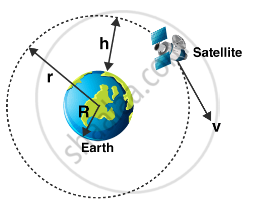Advertisements
Advertisements
Question
Is it possibe for a body to have inertia but no weight?
Solution
The weight of a body is the force with which it is attracted towards the centre of earth. When a body is stationary with respect to the earth, its weight equals gravity. This weight of the body is known as its static or true weight.
Inertia is a property of mass. Hence, a body can have inertia (i.e., mass) but no weight. Everybody always has inertia but its weight (mg) can be zero when it is taken at the centre of the earth or during free fall under gravity or a body placed at a very large distance from the earth. Basically, the weight of a body can be zero when acceleration due to gravity is zero, that condition is called weightlessness.

For example, When a satellite revolves in its orbit around the earth: Weightlessness possess many serious problems for astronauts. It becomes quite difficult for them to control their movements. Everything in the satellite has to be kept tied down. They can be displaced due to their inertia. The creation of artificial gravity is the answer to this problem
APPEARS IN
RELATED QUESTIONS
Is it necessary for the plane of the orbit of a satellite to pass through the centre of the earth?
A Mars satellite moving in an orbit of radius 9.4 × 103 km takes 27540 s to complete one revolution. Calculate the mass of Mars.
What is the true weight of an object in a geostationary satellite that weighed exactly 10.0 N at the north pole?
Draw a labelled diagram to show different trajectories of a satellite depending upon the tangential projection speed.
Answer the following question in detail.
Obtain an expression for the binding energy of a satellite revolving around the Earth at a certain altitude.
Answer the following question in detail.
What is a critical velocity?
Two satellites of a planet have periods of 32 days and 256 days. If the radius of the orbit of the former is R, the orbital radius of the Latter is ______
In the case of earth, mean radius is 'R', acceleration due to gravity on the surface is 'g', angular speed about its own axis is 'ω'. What will be the radius of the orbit of a geostationary satellite?
Satellites orbiting the earth have finite life and sometimes debris of satellites fall to the earth. This is because ______.
A satellite is revolving around a planet in a circular orbit close to its surface and ρ is the mean density and R is the radius of the planet, then the period of ______.
(G = universal constant of gravitation)
